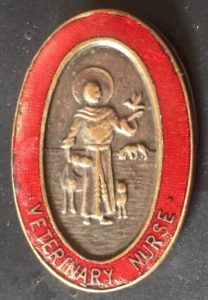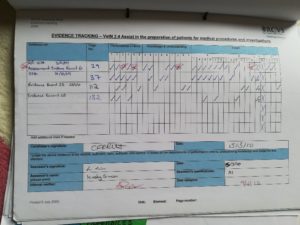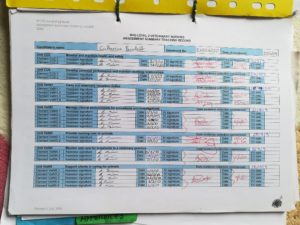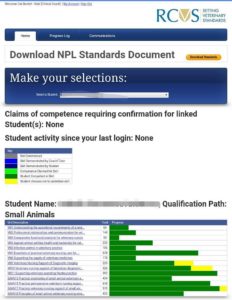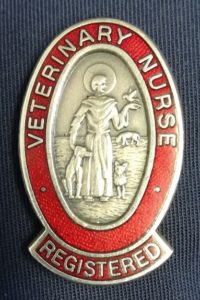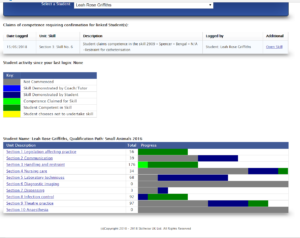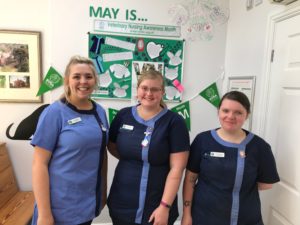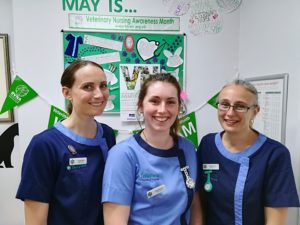Veterinary Nursing History
As early as 1888 a prominent veterinary scientist wrote that nursing required “strict attention to the animal’s comfort and well-being in matters of warmth, quietude, cleanliness, pure air and diet”.
By 1925 there was a canine distemper hospital in London staffed with specially trained canine nurses.
In 1934 King George V’s veterinary surgeon tried to get the Royal College of Veterinary Surgeons (RCVS) to recognise the title “Canine nurse” if nurses pass a suitable examination and held a certificate of efficiency. They refused but he felt certain they would change their minds sooner rather than later.
A veterinary textbook written in 1947 contained a chapter about veterinary nursing and again called for a registration system which would be a sign of competence.
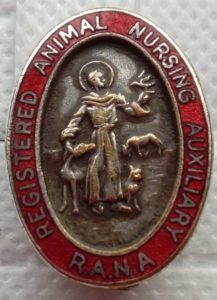 Finally, in 1961, the Registered Animal Nursing Auxiliary (RANA) scheme was approved and veterinary nursing became an officially recognised professional qualification with the first nurses qualifying in 1962. This did not however include a disciplinary system holding RANAs anymore accountable than lay-staff in the treatment of veterinary patients.
Finally, in 1961, the Registered Animal Nursing Auxiliary (RANA) scheme was approved and veterinary nursing became an officially recognised professional qualification with the first nurses qualifying in 1962. This did not however include a disciplinary system holding RANAs anymore accountable than lay-staff in the treatment of veterinary patients.
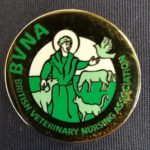 The British Veterinary Nursing Association (BVNA) formed in 1965 but the title Veterinary Nurse was not used until 1984 as the term “nurse” was protected until then, this meant the BVNA had to change their name to the British Animal Nursing Auxiliary Association until 1984 when the statue expired.
The British Veterinary Nursing Association (BVNA) formed in 1965 but the title Veterinary Nurse was not used until 1984 as the term “nurse” was protected until then, this meant the BVNA had to change their name to the British Animal Nursing Auxiliary Association until 1984 when the statue expired.
In 1991 the Veterinary Surgeons Act 1966 was amended to formally recognise the role of the veterinary nurse in law.
In the 1990’s Veterinary Nurse training consisted of a small green book that contained a list of tasks that had to be carried out. The veterinary surgeon signed the book when a task had been completed.
The Nursing exam consisted of a short answer paper, a multiple choice paper and a practical exam. Qualification enabled Veterinary Nurses to enter the List of VNs.
The RCVS was accredited as an awarding body for vocational qualifications in 1997 meaning that in 1998 they started to offer nationally recognised vocational qualifications (NVQs)and the first undergraduate courses became available.
In 2000 the first equine veterinary nurses qualified. Student Veterinary Nurses (SVNs) began logging their clinical skills in the form of a portfolio. This was built up of case reports written about the clinical skills learnt and used in practice whilst treating patients.
2002 established the Veterinary Nurses Council and the first cohort were awarded BSc Hons in Veterinary Nursing.
The non-statutory Register of veterinary nurses started in 2007 and the first veterinary nurse was given a place on the RCVS council in 2010.
2011 brought both the introduction of the Nursing Progress Log, an online tool to log clinical skills training and competence and the introduction of a disciplinary system for Registered Veterinary Nurses and in 2012 a new Code of Professional Conduct included, for the first time, a declaration to be made by Registered Veterinary Nurses on professional registration.
2013 saw the end of the RCVS offering the vocational Level 3 Diploma in Veterinary Nursing. with new awarding bodies taking over. The RCVS Council approved changes to the veterinary nursing Bylaws in order to strengthen its role as a regulatory body and be better able to ensure that qualified veterinary nurses are fit to practice and accountable for their actions.
The Royal Charter came into force in 2015 to end the List of VNs and move all qualified VNs over onto the Register, and now all qualified VNs are RVNs and are regulated by the RCVS.
In 2016 RVNs campaigned for protection of the title ‘Veterinary Nurse’ and despite gaining 37,000 signatures (double the number of RVNs and SVNs at the time) they were unsuccessful in doing so. The NPL was updated to reflect the clinical skills required by an RVN at ‘day one’ of their professional life.
The RCVS held a consultation on Schedule 3 (the section of the RCVS code of professional conduct relating to RVNs and SVNs) in 2017 to help shape the future of veterinary nursing. This was open to both vets and nurses to comment on and suggest changes to the current legislation.
2018 the VN Futures Action Group has created several working groups focusing on a number of ambitions and creating specific actions to ensure their completion. The ambitions of VN Futures include: Creating a sustainable workforce, structured and rewarding career paths, Proactive role in one health, maximising nurse’s potential and confident, resilient, healthy and well-supported workforce.
At Hollybank our RVNs have all qualified at different times and worked through different periods within the veterinary nursing timeline. From the Green book to the NPL we are lucky enough to be able to utilise our nurses shared experience of over 43 years! That doesn’t take into account the time they spent training and the skills brought to our team by our SVNs.
Thank you to the veterinary nursing community for providing photos.


